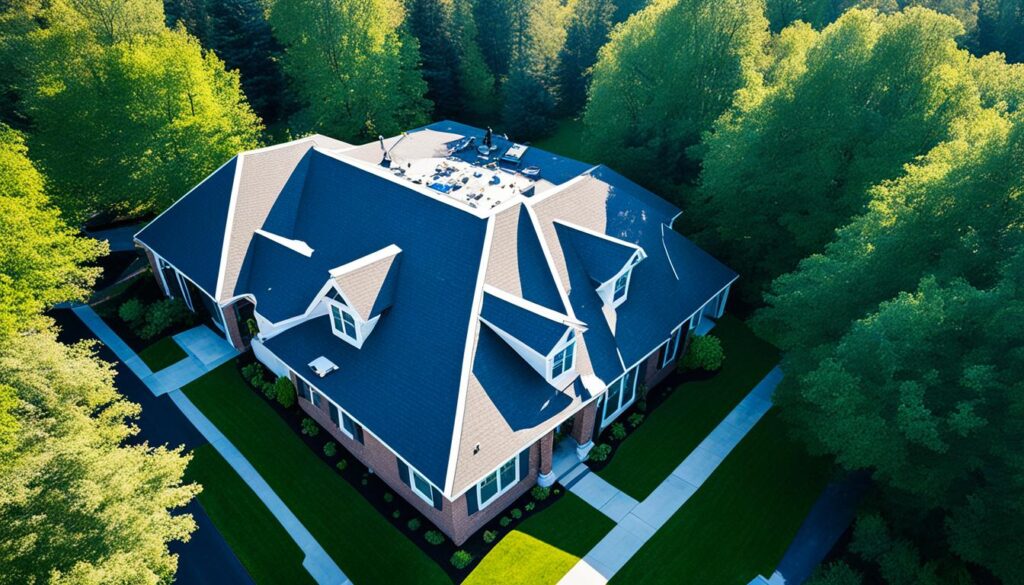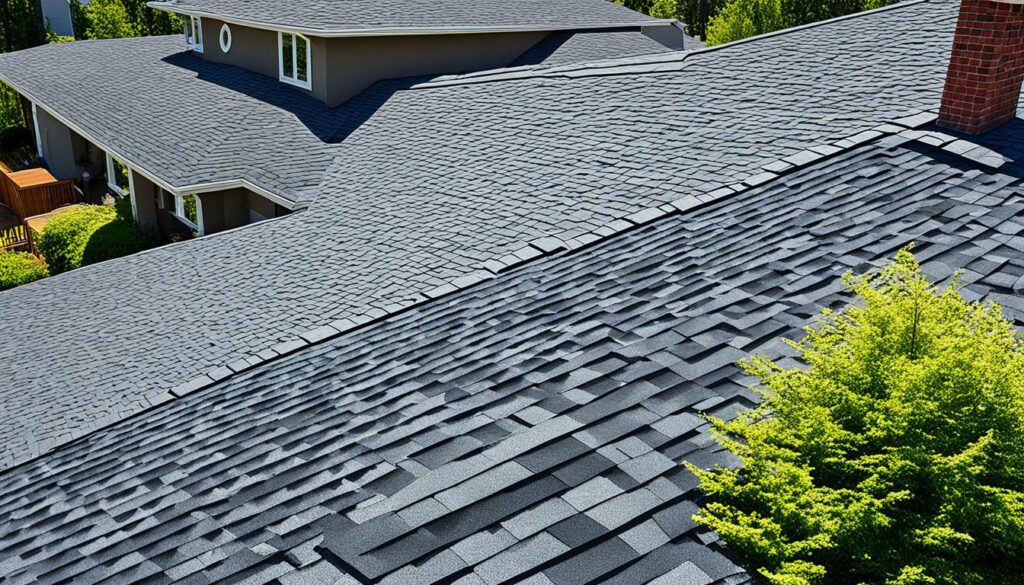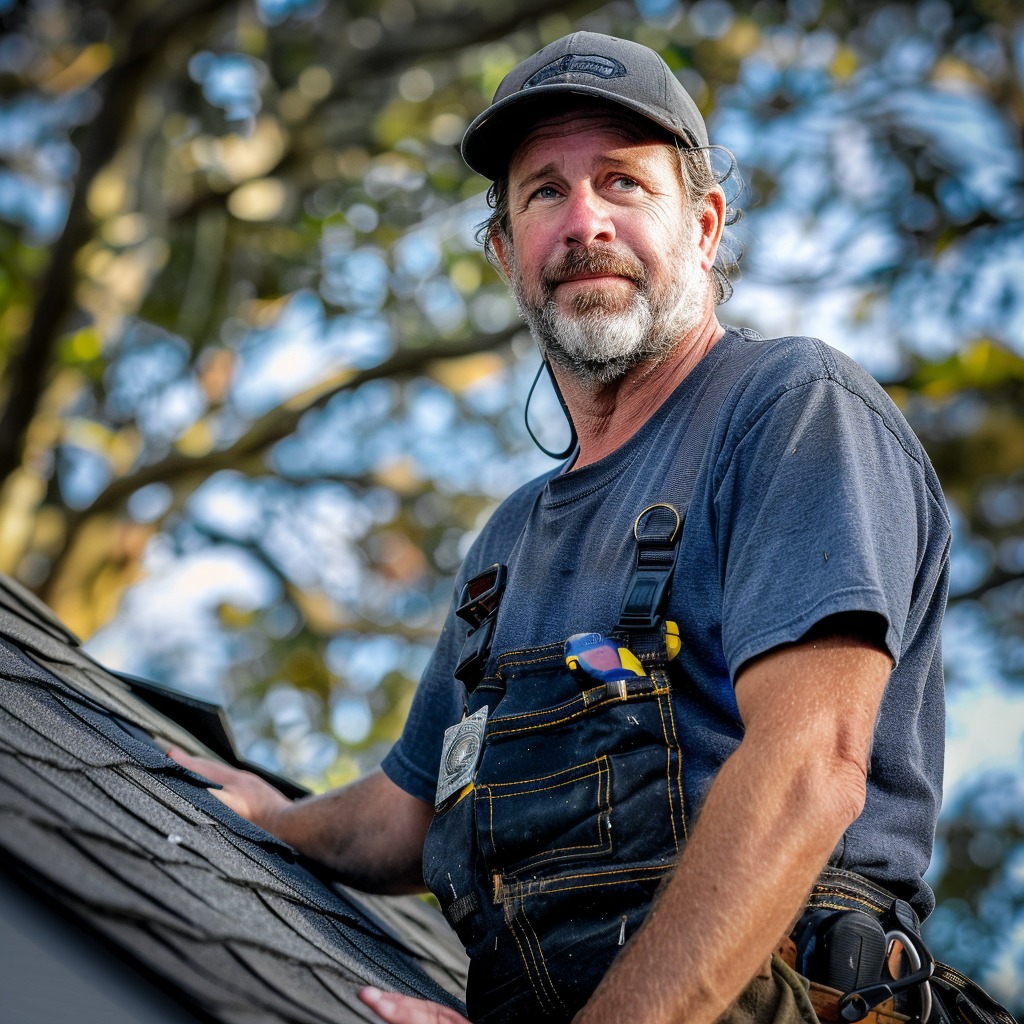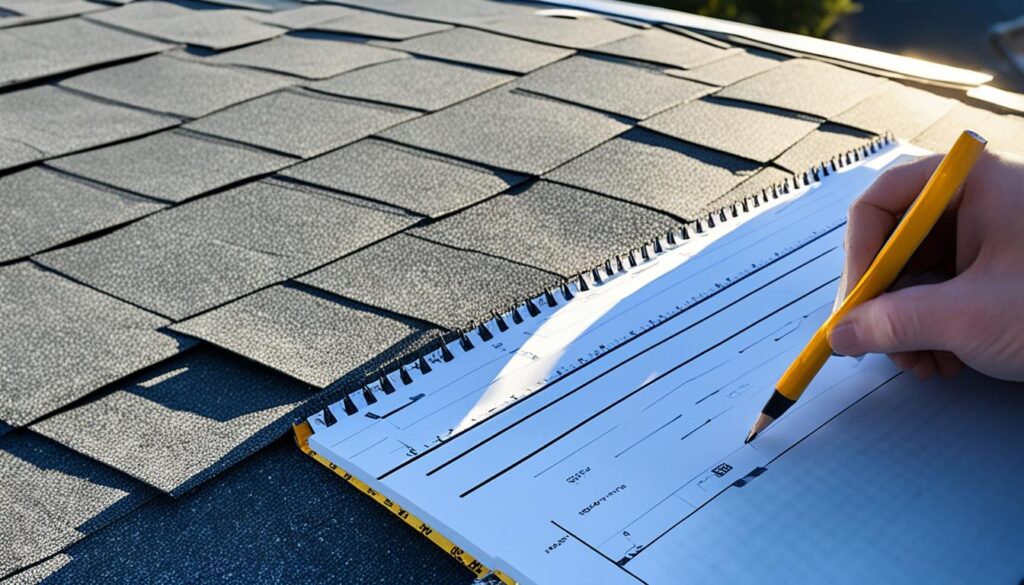Have you ever wondered how to accurately measure the square footage of your roof? The size of your roof plays a crucial role in determining the cost of a roof replacement. It affects the amount of materials, labor, and time required for the project. But how can you measure it accurately without professional help?
Calculating the square footage of a roof may seem like a complex task, but fear not! In this article, we will guide you through the process of measuring your roof’s square footage. We will teach you how to calculate the footprint of your home, factor in the slope and complexity of your roof, and ultimately determine the size of your roof. With this knowledge, you will be able to budget and plan for a roof replacement with confidence.
Key Takeaways:
- Accurately measuring the square footage of your roof is crucial for budgeting and planning a roof replacement.
- Calculating the footprint of your home is the first step in determining the square footage of your roof.
- The slope and complexity of your roof impact the square footage calculation, requiring multiplication factors.
- By using the appropriate equations and factors, you can get a rough estimate of your roof’s square footage.
- Remember, square footage is just one factor in determining the cost of a roof replacement.
Calculating the Footprint of Your Home
To accurately figure out your home’s footprint, you need to measure its length and width. This step is crucial in calculating the square footage of your roof. There are two methods you can use to measure the dimensions: stepping off the dimensions or using a measuring tape.
If you choose to step off the dimensions, start at one corner of your home and walk in a straight line, counting each step. Once you reach the opposite corner, stop counting and record the total number of steps taken. Repeat this process for the width of your home. Although this method may not be as precise as using a measuring tape, it can provide a rough estimate.
If you prefer a more accurate measurement, use a measuring tape to measure the length and width of your home. Start at one corner and extend the tape measure along the side of your home until you reach the opposite corner. Take note of the measurement in feet and inches. Repeat this process for the width of your home as well.
Once you have the measurements, multiply the length by the width to calculate the footprint of your home. For example, if your home’s length is 60 feet and the width is 30 feet, the calculation would be:
Footprint = Length x Width = 60 ft x 30 ft = 1800 sq ft
Keep in mind that the square footage of a house does not necessarily equal the square footage of a roof. To determine the square footage of your roof, you will need to consider the slope and complexity of the roof, which will be covered in the next section.
| Measurement | Length (in feet) | Width (in feet) |
|---|---|---|
| Home | 60 | 30 |
Considering the Slope and Complexity of Your Roof
When calculating the square footage of your roof, it is crucial to take into account the slope and complexity of your roof. These factors have a direct impact on the overall calculation and accuracy of your estimate. By keeping slope and complexity in mind, you can ensure that your measurements are as precise as possible.
The slope of your roof refers to its incline or angle. Different roof types have varying degrees of slope, and it is essential to consider this when determining the square footage. To adjust for this, you need to multiply the footprint of your home by a specific factor based on the slope of your roof.
A walkable gable roof, which has a moderate slope, requires multiplying the footprint of your home by a factor of 1.3. This compensates for the increased area created by the angle of the roof. On the other hand, a hip roof with a low slope requires multiplying the footprint by a factor of 1.4. This takes into account the additional surface area that comes from the unique shape of a hip roof.
For roofs with steeper inclines and higher complexity, such as those with multiple gables, dormers, or valleys, the multiplication factor increases to 1.6. These factors account for the additional surface area created by the intricate design of the roof.
To summarize, when calculating the square footage of your roof, it is essential to keep slope and complexity in mind. Multiply the footprint of your home by the appropriate factor based on the type of roof you have to ensure an accurate estimate of the roof’s size.
Example Calculation:
Let’s say the footprint of your home, based on its length and width, is 1,500 square feet. If you have a walkable gable roof, you would multiply this by 1.3:
(1,500 square feet) x (1.3) = 1,950 square feet
Factors Affecting the Roof Square Footage Calculation:
| Roof Type | Multiplication Factor |
|---|---|
| Walkable Gable Roof | 1.3 |
| Hip Roof with Low Slope | 1.4 |
| Steep and Complex Roofs | 1.6 |
Calculating the Square Footage of Your Roof
Now that you have determined the footprint of your home and considered the slope and complexity of your roof, you can calculate the square footage. Follow this simple equation:
(length of home) x (width of home) = (footprint of your home)
Once you have the footprint, you’ll need to multiply it by the appropriate factor based on the slope and complexity of your roof. This will give you a rough estimate of the square footage of your roof. While it may not be 100% accurate, it provides a basis for understanding the size and potential cost of your roof replacement.

Example Calculation:
Let’s say your home has a length of 40 feet and a width of 30 feet, resulting in a footprint of 1,200 square feet. If you have a walkable gable roof, you would multiply the footprint by a factor of 1.3, giving you an estimated square footage of 1,560 square feet. Remember, this is just a rough estimate!
| Slope and Complexity | Multiplication Factor |
|---|---|
| Walkable Gable | 1.3 |
| Hip Roof with Low Slope | 1.4 |
| Steep and Complex Roof | 1.6 |
Keep in mind that actual roofing professionals will provide the most accurate measurement, but this equation gives you a useful starting point. Once you have the estimated square footage, you can move on to considering other factors that impact the cost of your roof replacement, such as the type of roof, labor, and operating costs.
Factors Impacting the Cost of a Roof Replacement
When considering a roof replacement, it’s important to understand that square footage is just one of many factors that impact the cost. Several other key factors come into play, including the type of roof, labor and time requirements, and the operating costs of the roofing contractor.
Type of Roof: The choice of roof material has a significant impact on the cost of replacement. Basic asphalt shingles are generally more affordable compared to premium materials like cedar shake or slate. It’s essential to consider the durability, lifespan, and aesthetics of different roofing options when determining the overall cost.
Labor and Time: The complexity and accessibility of your roof directly affect the labor and time required for the replacement project. A straightforward gable roof with minimal obstructions may be completed more quickly and cost-effectively compared to a roof with multiple angles, valleys, or chimneys.
Operating Costs: The operating costs of the roofing contractor are also factored into the final cost. These costs include insurance, licenses, and the training of the roofing team. Contractors with higher operating costs may charge more for their services, but they often provide greater professionalism and expertise.
By taking into account these factors impacting roof cost, you can make an informed decision when planning your roof replacement. Remember, the type of roof, labor and time requirements, and the operating costs of the contractor all play a significant role in determining the overall cost of your roof replacement project.
Additional Factors Affecting the Cost of a Roof Replacement
In addition to square footage and the factors mentioned in the previous section, there are other elements that can affect the cost of a roof replacement. The choice of materials, warranty offerings, and the reputation of the roofing contractor can all impact the overall cost.
When it comes to materials, opting for premium options will typically result in a higher cost compared to basic asphalt shingles. Premium materials such as metal, clay tiles, or slate are more expensive but offer enhanced durability and aesthetic appeal.
A warranty is another important consideration. Longer warranties may come at a higher price upfront, but they provide added peace of mind, protecting your investment for an extended period. Before making a decision, carefully review the warranty terms and coverage details.
The reputation of the roofing contractor is also significant. Established and reputable contractors with a proven track record often charge higher prices due to their experience, quality of work, and customer satisfaction. While it may be tempting to choose a cheaper option, hiring a reputable contractor can ultimately save you money in the long run by ensuring proper installation and minimizing the risk of future issues.
To summarize, the additional factors that can influence the cost of a roof replacement include:
- Choice of materials
- Warranty offerings
- Reputation of the roofing contractor

Comparison of Roofing Material Costs
| Roofing Material | Average Cost per Square Foot |
|---|---|
| Asphalt Shingles | $3 – $7 |
| Metal Roofing | $5 – $12 |
| Clay Tiles | $10 – $20 |
| Slate | $20 – $40 |
“Choosing premium materials, opting for a longer warranty, and hiring a reputable contractor may increase the initial cost of a roof replacement, but they can provide long-term benefits in terms of durability, aesthetics, and peace of mind.” – [Author Name]
Conclusion
Measuring the square footage of your roof is an essential step in understanding the cost and planning for a roof replacement. While a professional roofing contractor can provide the most accurate measurement, there are calculations you can do to get a rough estimate.
By determining the footprint of your home, considering the slope and complexity of your roof, and using the appropriate multiplication factors, you can calculate the square footage of your roof. This will give you a basis for understanding the size and potential cost of your roof replacement. However, it’s important to remember that square footage is just one factor that affects the cost.
Other factors such as the type of roof, labor and time required, and operating costs of the contractor should also be taken into consideration when budgeting for a roof replacement. Factors like the choice of materials, warranty offerings, and the reputation of the roofing contractor can all impact the overall cost of the project. Therefore, it’s crucial to weigh all these factors and consult with professionals to make an informed decision for your roof replacement.

Meet William Adams, a seasoned roofing expert with over 30 years of hands-on experience in the industry. Having worked tirelessly under the scorching sun and through the fiercest storms, William brings a wealth of knowledge and expertise to the table. Hailing from the heart of the USA, he’s witnessed the evolution of roofing practices firsthand, mastering every aspect along the way. Now retired from the field, William spends his days cherishing time with his loved ones while sharing his invaluable insights through this platform. With William at the helm, you can trust that every tip, advice, and recommendation provided is backed by years of real-world experience and unwavering dedication to quality craftsmanship. Join us as we journey through the world of roofing, guided by the wisdom and passion of a true industry veteran.

